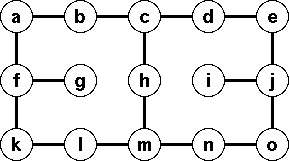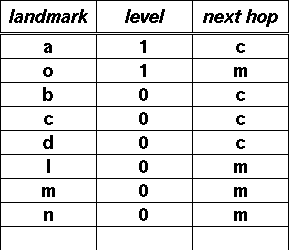|
|
|
|
Extra Homework
(do not turn in)
|
| |
|
Problem 1
|
Description
In Section 3 of [Tsuchiya88a],
the author gave a brief description of a
hierarchy management algorithm which
is used to build a hierarchy of Landmarks from the bottom up.
Your job is to:
- Write out such an algorithm in detail.
- Apply your algorithm to the physical network shown below
assuming that the radius of a level n landmark router
is 2^(n+1) (2 raised to the power of n+1).
-

Requirements
- Prepare a detailed description of your hierarchy management algorithm.
You may find proposed solutions to this problem by searching the
Internet. If you find such a proposal, you may not simply
copy the algorithm and turn it in. In this case, you must study
the algorithm and understand it throughly and describe the algorithm
in your own words. If your solution comes from such a souce,
you must also cite your source.
- For part (2), please write down your answers in a table with the
following columns:
- original name
(i.e., a, b, c, ... in alphabetical order)
- new name
- (landmark) level
- orignal names of landmarks visible in routing table
(you do not need to write down level and nexthop values)
Hints
If you are stuck,
[Estrin99a] may have some
helpful hints.
|
| |
|
Problem 2
|
Description
Let the physical network topology be as shown above.
Furthermore, let the radius of a level n landmark router
is 2^(n+1) (2 raised to the power of n+1.
Questions
- What's the minimum number of LM1 router(s) you must have?
- Continue from part (1), which LM0 router(s) will you promote to
be LM1 router(s) to achieve this minimum?
- What's the minimum number of LM2 router(s) you must have?
- Continue from part (3), which LM1 router(s) will you promote to
be LM2 router(s) to achieve this minimum?
- Continue from part (4), please write down the routing table at
node h.
Anaswers
- three
- a, h, and o
- one
- h
-
-

|
| |
|
Problem 3
|
Description
Solve the WFQ problem on
slide 33 of lecture 15.
- Three input queues, X, Y, and Z. Their weights are 1, 2, and 1,
respectively.
- Packet sizes are identical and equal to 1.
- Packet arrivals are as follows.
- At real time 1, one packet (X1) arrives at queue X and
onen packet (Z1) arrives at queue Z.
- At real time 2, one packet (Y2) arrives at queue Y.
- At real time 3, one packet (X3) arrives at queue X.
- At real time 4, one packet (Z4) arrives at queue Z.
- At real time 5, one packet (Y5) arrives at queue Y.
Requirements
Solution
|
| |
|


